Abstract
Nevoid basal cell carcinoma syndrome (NBCCS), also known as Gorlin syndrome, is characterized by various embryological deformities and carcinoma formation. It is caused by PTCHI gene mutations and is autosomal dominantly inherited. Some of the main symptoms of NBCCS are multiple basal cell carcinomas, multiple keratocystic odontogenic tumors (KCOTs) of the mandible, hyperkeratosis of the palmar and plantar, skeletal deformity, calcification of the falx cerebri, and facial defomity. Recurrent KCOT is the main symptom of NBCCS and is present in approximately 90% of patients. In NBCCS, KCOTs typically occur in multiples. KCOTs can be detected in patients under the age of 10, and new and recurring cysts develop until approximately the age of 30. The postoperation recurrence rate is approximately 60%. This case report presents a 14-year-old female patient with a chief complaint of a cyst found in the maxilla and mandible. The patient was diagnosed with NBCCS, and following treatment of marsupialization and enucleation, the clinical results were satisfactory.
Nevoid basal cell carcinoma syndrome (NBCSS), also known as basal cell nevus syndrome (BCNS) or Gorlin syndrome1, is autosomal dominantly inherited and related to chromosome 9q22.3-q31, with various clinical appearances2.
Basal cell carcinomas of the skin or basal cell nevi, multiple keratocystic odontogenic tumors (KCOTs) in the jaw, rib and vertebral anomalies, and calcification of the skull are the major symptoms of NBCCS and minor symptoms, such as frontal bone and parietal bone protrusion, hypertelorism, cleft lip, and cleft palate, are also occasionally seen3. Based on these clinical and radiographic symptoms, Evans et al.4 reported that diagnosis of NBCCS can be made when two out of five major criteria, or one major and two out of six minor criteria, are met. Major criteria include (1) basal cell carcinoma, (2) KCOT, (3) palmar or plantar pits, (4) ectopic calcification, and (5) family history of NBCCS. Minor criteria include (1) skeletal anomaly, (2) macrocephaly, (3) cardiac or ovarian fibroma, (4) medulloblastoma, (5) lymphomesenteric cyst, and (6) congenital malformation.
This case report presents a 14-year-old female patient with a chief complaint of a cyst found in the maxilla and mandible. The patient was diagnosed with NBCCS, and following treatment of marsupialization and enucleation, the clinical results were satisfactory.
A 14-year-old female patient was referred with a chief complaint of a cyst in the maxillary sinus and mandible. There were no other clinical symptoms, such as intraoral edema or pain. The eruption-delayed right mandibular second molar had partially erupted and showed a negative response for electric pulp test. A well-defined, translucent, cystic lesion in the left maxillary sinus, as well as a cyst from the right mandibular second molar to the right mandibular ramus, was seen in the panoramic radiograph.(Fig. 1)
After a biopsy of the maxillary and mandibular cysts and the insertion of a Foley catheter for decompression, an impression was taken, and an individual obturator was fabricated. Based on the biopsy results, both cystic lesions were diagnosed as KCOTs.(Fig. 2) The patient also showed marked hypertelorism. Additionally, the chest radiograph showed a bifid rib in the right third rib.(Fig. 3) Calcification of the falx cerebri was observed in the skull PA and Water's radiograph. (Fig. 4, 5) Basal cell nevus and nevoid basal cell carcinoma were not observed. Based on the criteria of Evans et al.4, the patient was diagnosed with NBCCS since 2 major criteria and 2 minor criteria were observed.
The patient washed the lesion area by herself using saline twice a day and was seen for follow-up appointments every 2 months. After 7 months, the size of the right mandibular ramus cyst decreased by 46% compared to its initial examination, based on the panoramic radiograph.(Fig. 6) Computed tomography scans also showed a decrease in the size of the left maxillary sinus and right mandibular ramus cysts. Based on these data, a decision was made that the lesion would no longer decrease in size, therefore a cyst enucleation was performed under general anesthesia.
After 4 years of follow-up, no recurrence of the cyst in the right mandibular ramus was observed. Two years after the initial examination, a new cystic lesion was found in the left premolar area. A cyst enucleation was performed under local anesthesia, and the cyst was diagnosed as a KCOT based on the biopsy results. Additionally, a recurrence of the cyst in the left maxillary sinus was found in the radiographic examination 2 years after the initial operation. A cyst enucleation was performed under general anesthesia, and the operation site is being checked in follow-up appointments every 6 months.(Fig. 7)
Since Jarisch first described the many symptoms of NBCCS in 1894, Gorlin and Goltz5 grouped these symptoms into a single syndrome in 1960 and reported cyst in the jaw, skeletal anomaly, and multiple basal cell nevus as the three main symptoms. In 1993, Evans et al.4 suggested 5 major criteria and 6 minor criteria for the diagnosis of NBCCS. If the patient satisfies two major criteria, or one major and two minor criteria, the patient should be diagnosed with NBCCS. The prevalence rate is 1:60,0006 with no sexual predominance7.
Basal cell carcinoma is seen in 50% to 97% of NBCCS patients and shows different incidence rates between races of 80% in Caucasians8, 38% in African-Americans9, and 15.2% in Koreans10. Basal cell carcinoma can occur anywhere on the skin but is mainly found in the chest and cervicofacial areas due to exposure to sunlight11. It may occur before puberty but mainly occurs between puberty and the age of 352. It has been reported to sometimes change to an invasive lesion after puberty2. In the current case, the patient was diagnosed with NBCCS at the age of 14 and received periodic dermatological examinations over the next 4 years (up to the current date), but no basal cell carcinoma was observed.
Rib anomalies, such as bifid rib, costal agenesis, and costal fusion, are common in NBCCS due to skeletal anomalies, and scoliosis and polydactylism are also seen5. In the case of rib anomalies, such as in this case, no other clinical symptoms are generally observed. Central nervous system disorders, such as mental retardation, congenital hydrocephalus, and rarely, epilepsy, have also been reported12. Medulloblastoma is a commonly accompanying tumor that occurs in 3% to 5% of patients2. Also, hypertelorism, calcification of the ovaries, fibroma, cleft palate, and ophthalmic anomalies, such as strabismus and glaucoma, have been reported4.
KCOTs are found in 65% to 100% of NBCCS patients and occur frequently in patients in their teens and twenties13. This symptom occurs earlier than other symptoms of NBCCS, so it serves as an opportunity to diagnosis NBCCS, such as in this case. However, although rare, non-syndromal multiple KCOTs have been reported14. The postoperative recurrence rate of KCOTs in NBCCS is 30% to 60%15, which is higher than that of patients with only KCOTs. This is because of its genetic trait that causes new cysts to occur in basal cell layers. KCOT occurs in multiple and the size of the epithelial cells is smaller and pseudo-benign cysts are more common16. In this case, the KCOT in the left maxillary sinus relapsed during follow-up, and a new KCOT was found in the left maxillary premolar area during treatment. In the case of large cysts, size reduction through marsupialization and decompression followed by enucleation is helpful for the complete removal of the cyst and prevention of recurrence2.
Because of the high recurrence rate of multiple KCOTs in the jaws of NBCCS patients, early diagnosis, as well as clinical and radiographic follow-up, is necessary17. Since other medical problems exist with NBCCS, in addition to the recurrence of KCOTs, multiple treatments by experts from other fields is required. Also, genetic examination in terms of family history and follow-up is required, if possible.
References
2. Manfredi M, Vescovi P, Bonanini M, Porter S. Nevoid basal cell carcinoma syndrome: a review of the literature. Int J Oral Maxillofac Surg. 2004; 33:117–124. PMID: 15050066.

3. Bakaeen G, Rajab LD, Sawair FA, Hamdan MA, Dallal ND. Nevoid basal cell carcinoma syndrome: a review of the literature and a report of a case. Int J Paediatr Dent. 2004; 14:279–287. PMID: 15242385.

4. Evans DG, Ladusans EJ, Rimmer S, Burnell LD, Thakker N, Farndon PA. Complications of the naevoid basal cell carcinoma syndrome: results of a population based study. J Med Genet. 1993; 30:460–464. PMID: 8326488.

5. Gorlin RJ, Goltz RW. Multiple nevoid basal-cell epithelioma, jaw cysts and bifid rib. A syndrome. N Engl J Med. 1960; 262:908–912. PMID: 13851319.
6. Gorlin RJ. Nevoid basal cell carcinoma (Gorlin) syndrome: unanswered issues. J Lab Clin Med. 1999; 134:551–552. PMID: 10595780.

7. Kakarantza-Angelopoulou E, Nicolatou O. Odontogenic keratocysts: clinicopathologic study of 87 cases. J Oral Maxillofac Surg. 1990; 48:593–599. discussion 599-600. PMID: 2187964.
8. Kimonis VE, Goldstein AM, Pastakia B, Yang ML, Kase R, DiGiovanna JJ, et al. Clinical manifestations in 105 persons with nevoid basal cell carcinoma syndrome. Am J Med Genet. 1997; 69:299–308. PMID: 9096761.

9. Goldstein AM, Pastakia B, DiGiovanna JJ, Poliak S, Santucci S, Kase R, et al. Clinical findings in two African-American families with the nevoid basal cell carcinoma syndrome (NBCC). Am J Med Genet. 1994; 50:272–281. PMID: 8042672.

10. Ahn SG, Lim YS, Kim DK, Kim SG, Lee SH, Yoon JH. Nevoid basal cell carcinoma syndrome: a retrospective analysis of 33 affected Korean individuals. Int J Oral Maxillofac Surg. 2004; 33:458–462. PMID: 15183409.

11. Gorlin RJ. Nevoid basal-cell carcinoma syndrome. Medicine (Baltimore). 1987; 66:98–113. PMID: 3547011.

12. Lo Muzio L. Nevoid basal cell carcinoma syndrome (Gorlin syndrome). Orphanet J Rare Dis. 2008; 3:32. PMID: 19032739.

14. Ozkan L, Aksoy S, Orhan K, Cetiner S, Uyanik LO, Buhara O, et al. Case report: multiple keratocystic odontogenic tumour in a non-syndromal pediatric patient. Eur J Paediatr Dent. 2014; 15(2 Suppl):241–244. PMID: 25101513.
15. Vedtofte P, Praetorius F. Recurrence of the odontogenic keratocyst in relation to clinical and histological features. A 20-year follow-up study of 72 patients. Int J Oral Surg. 1979; 8:412–420. PMID: 120338.
16. Donatsky O, Hjørting-Hansen E. Recurrence of the odontogenic keratocyst in 13 patients with the nevoid basal cell carcinoma syndrome. A 6-year follow-up. Int J Oral Surg. 1980; 9:173–179. PMID: 6777316.
17. Kulkarni GH, Khaji SI, Metkari S, Kulkarni HS, Kulkarni R. Multiple keratocysts of the mandible in association with Gorlin-Goltz syndrome: a rare case report. Contemp Clin Dent. 2014; 5:419–421. PMID: 25191087.

Fig. 1
Initial panoramic radiograph of a 14-year-old woman shows a right mandibular cystic lesion and haziness in the left maxillary sinus.
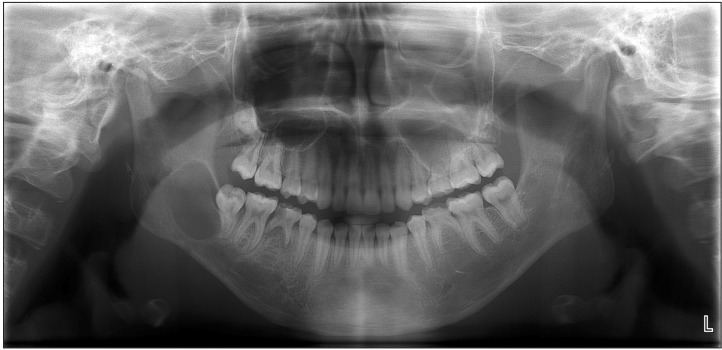
Fig. 2
Micrograph reveals a stratified epithelium lining with the connective tissue stroma of keratocystic odontogenic tumor (H&E staining, ×200).
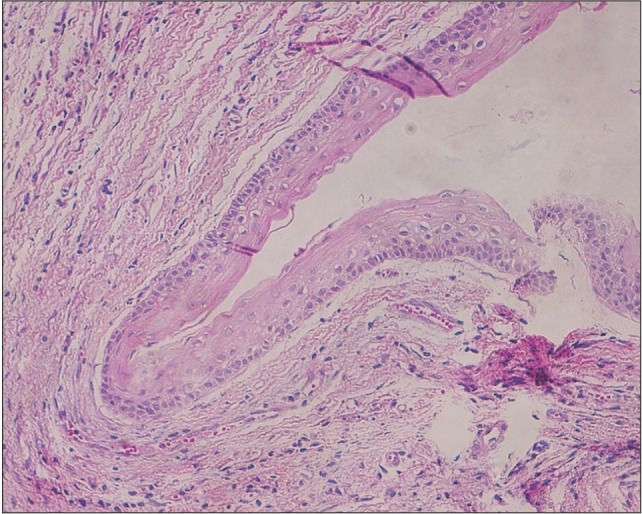




 PDF
PDF ePub
ePub Citation
Citation Print
Print



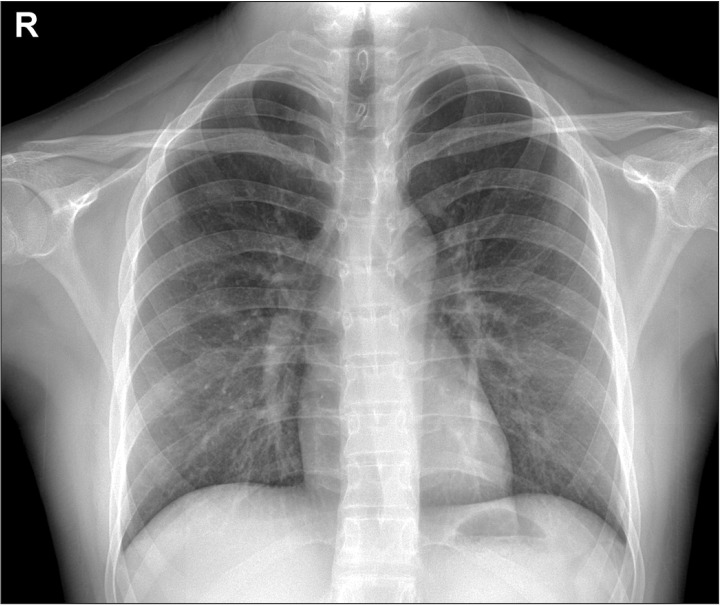
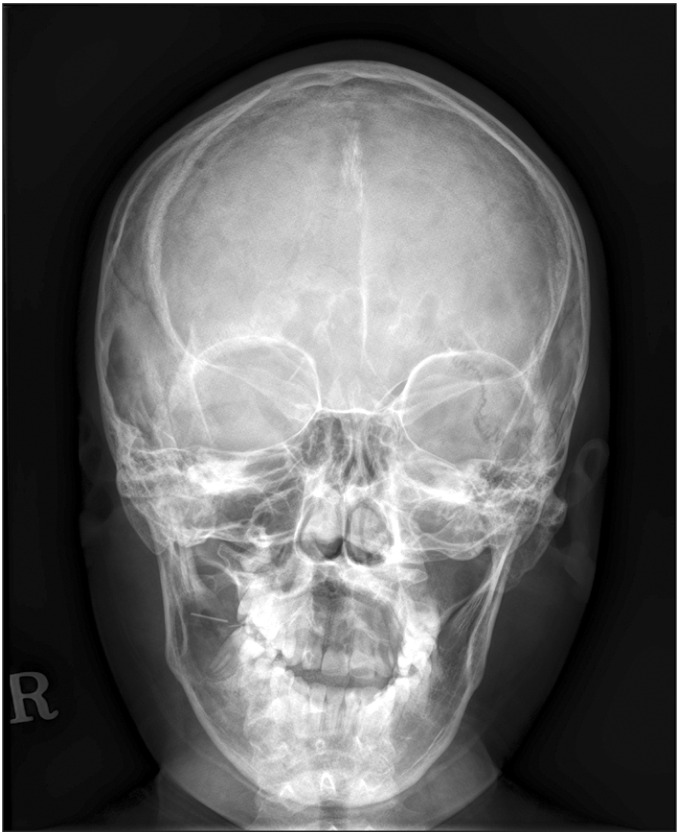
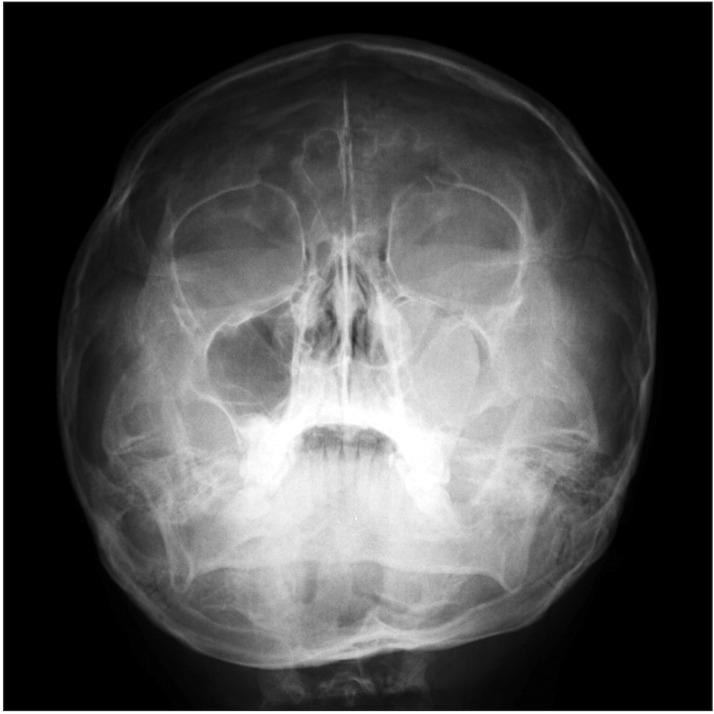
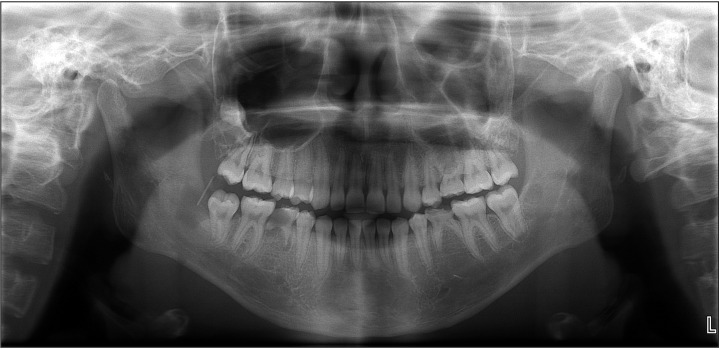
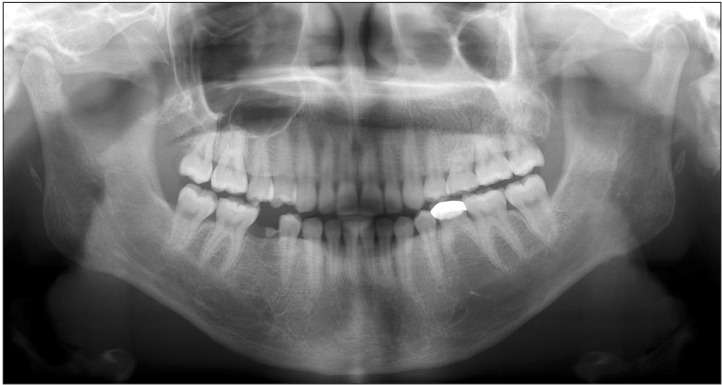
 XML Download
XML Download